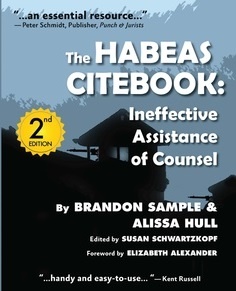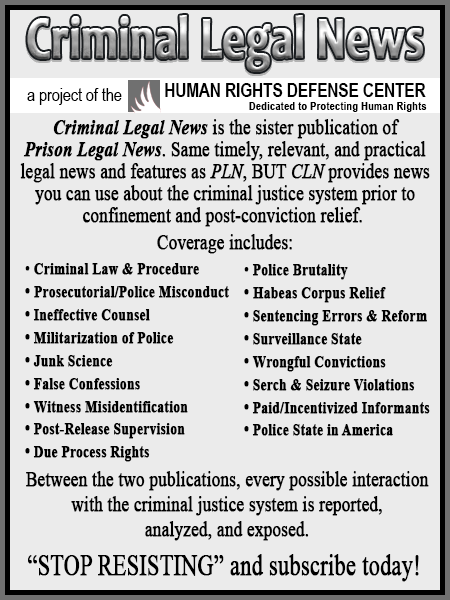From the Editor
by Richard Resch
As we usher in 2025, we also mark the eighth year of Criminal Legal News (“CLN”). To those of you who have been with us from the beginning, we extend our heartfelt gratitude for your continued support, which has been instrumental in our success. We are honored that readers find our content helpful and informative and will do our utmost to ensure CLN continues to be a valuable resource for your legal news.
This issue of CLN has been circulated to a wide and diverse audience beyond the usual suspects, so many individuals, including new subscribers, who have received a copy may not be familiar with CLN’s structure, mission, and philosophy. Accordingly, I’d like to provide a brief overview of CLN.
CLN is a monthly print and online publication focusing on individuals’ legal rights as they pertain to interactions with the criminal justice system. Specifically, CLN’s coverage includes, but is not limited to, state and federal criminal law and procedure, constitutional rights, police and prosecutorial misconduct, official abuse of power, habeas corpus relief, ineffective assistance of counsel, sentencing errors and reform, militarization of police, surveillance state, junk science, wrongful convictions, false confessions, witness misidentification, Brady violations, paid/incentivized informants, plea agreements, asset forfeiture, capital punishment, search and seizure, Miranda warnings, sex offender registries, post-release supervision and control, and due process rights.
Each issue of CLN features a cover story, expert legal commentary and analysis by a columnist, legal news articles, summaries of useful appellate court decisions, and News in Brief (short topical stories from around the country—from the sublime to the ridiculous). Each issue of CLN contains relevant, high-interest news stories about the criminal justice system and summaries of state and federal appellate court decisions, with the majority of content constituting the latter variety.
Our mission at CLN is to provide readers with practical legal information that can be used to challenge convictions, sentences, and conditions of release where warranted. The primary means of educating and informing readers is through coverage of state and federal appellate court decisions dealing with criminal law, procedure, and associated constitutional rights. We’re confident that the case law information we provide is of great value to anyone with an interest in the most recent developments in state and federal substantive criminal law and criminal procedure.
We believe that the breadth of our coverage is unique in that we review every opinion issued by the highest appellate court in all 50 states as well as from the 13 U.S. Courts of Appeals and the U.S. Supreme Court. CLN reports on decisions that implicate any of the issues we cover and meet our criteria for reporting, as follows: CLN reports on a decision if it (1) constitutes a win, in whole or in part, for the defendant, (2) announces a new rule of law, (3) expands, limits, modifies, or otherwise clarifies an existing rule of law, (4) involves a relevant issue of first impression, (5) provides usable information or guidance for our readers, or (6) is issued by the U.S. Supreme Court regardless of disposition. Finally, we also report on notable decisions from intermediate level state courts of appeal.
For each decision, we provide the (1) essential facts, (2) applicable rules of law, (3) application and reasoning, and (4) court’s holding. We do our best to distill decisions down to these four essential elements for practical use by our readers. However, given the sheer number of cases upon which we report, please understand that we cover them within fairly rigid word count parameters, ranging from about 500 to 1,500 words, and we are summarizing appellate court decisions that often run several dozen pages in length. Consequently, while we have the utmost confidence in our coverage and treatment of each decision upon which we report, our summaries are, nevertheless, no substitute for reading the actual opinions themselves if they apply to your situation.
In addition to reporting on the latest developments in criminal and constitutional case law, CLN provides unflinching and unapologetic coverage of criminal justice issues and news. There are no sacred cows at CLN; we critically examine and question everything and everyone associated with the criminal justice system.
For example, we challenge the axiomatic belief that’s become deeply ingrained in the law enforcement community and popular culture but poses a clear and present danger to public safety, viz., that an officer’s first priority is to go home to his or her family at the end of each shift. But is it? That belief inevitably leads many officers to develop a “shoot first and ask (or answer) questions later” mentality, which in turn frequently results in an unreasonable risk of injury to or even death of members of the general public.
If that genuinely is an officer’s ultimate priority, then everything else involved with being a member of the law enforcement community is subordinate, including taking reasonable and foreseeable risks that may place the officer in personal physical danger. But the assumption of a certain degree of risk to personal safety is an inherent, reasonable, and unavoidable aspect of being a law enforcement officer, much like it is with being a test pilot or stunt person. If you’re unwilling to assume that risk, then you have absolutely no business whatsoever being a test pilot, stunt person, or, far more importantly, a law enforcement officer. All three jobs are voluntary; no one is forced to do any of them. But if you choose to join any of those occupations, then you are also voluntarily choosing to accept the inherent risks that accompany it.
We have reported on a real-world example of this intolerable risk-averse mentality by a Tennessee police officer. The officer tasered an 81-year-old woman who allegedly brandished a rake in a “threatening manner” and ambled towards him from a distance of about 50 feet, leaving the petrified officer with a scant 14 seconds to react. The sheriff stood behind the decision, praising the officer because the only other options available, according to the sheriff, were to use lethal force or risk the officer’s own life. Really?!
If this scenario constitutes a legitimate life and death situation in the mind of this officer and the sheriff, then the community would be far better served and much safer without them on the force. If any situation involving even the slightest risk to an officer’s personal safety is viewed distortedly as presenting a binary choice between kill or be killed, which option do you suppose the officer will choose?
When law enforcement officers believe that their first priority is to make it home safely at the end of their shift, the acceptable degree of risk hovers around zero, and the public pays the price with octogenarians clutching gardening tools getting tased or worse.
Now, I’d like to talk briefly about our core philosophy. Call us wild-eyed optimists, but we at CLN don’t think it’s too much to ask members of the law enforcement community and prosecutors not to rape individuals in custody (or really anyone for that matter); brutalize or kill compliant suspects or members of the general public; plant or manufacture incriminating evidence; intentionally withhold exculpatory evidence from defendants; knowingly convict factually innocent people; and otherwise blatantly violate people’s constitutional rights, personal well-being, and human dignity.
So basically, we at CLN don’t believe it’s too much to demand that law enforcement officers and prosecutors obey the law and follow the rules that they’ve sworn to uphold. Unfortunately, if the foregoing horrendous behaviors weren’t occurring with terrifying regularity all across the country, there would be no need for CLN. But they are, so here we are.
Finally, many readers and random commentators have asked why the headlines for most of the court-opinion articles are so long and detailed. That’s a good question, and there’s a good explanation. Many of our readers are incarcerated (as are the majority of our writers, who are among the top jailhouse lawyers and imprisoned writers in the country), so they receive the print version of CLN, which they often keep after reading to serve as a reference library of sorts. Because the issues are in print, they are not easily searchable like the online version. If the headlines were short and generic, it would be more difficult for incarcerated readers to locate a specific article from a previous issue of CLN. Consequently, court-opinion article headlines are long and detailed to make it easier for incarcerated readers to search past print issues of CLN for specific topics and court opinions.
To those of you who haven’t already done so, “Stop resisting!” and subscribe to CLN today.
As a digital subscriber to Criminal Legal News, you can access full text and downloads for this and other premium content.
Already a subscriber? Login





